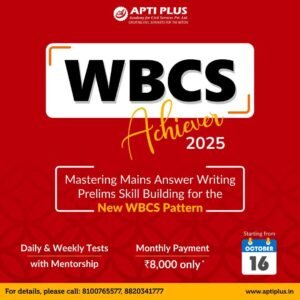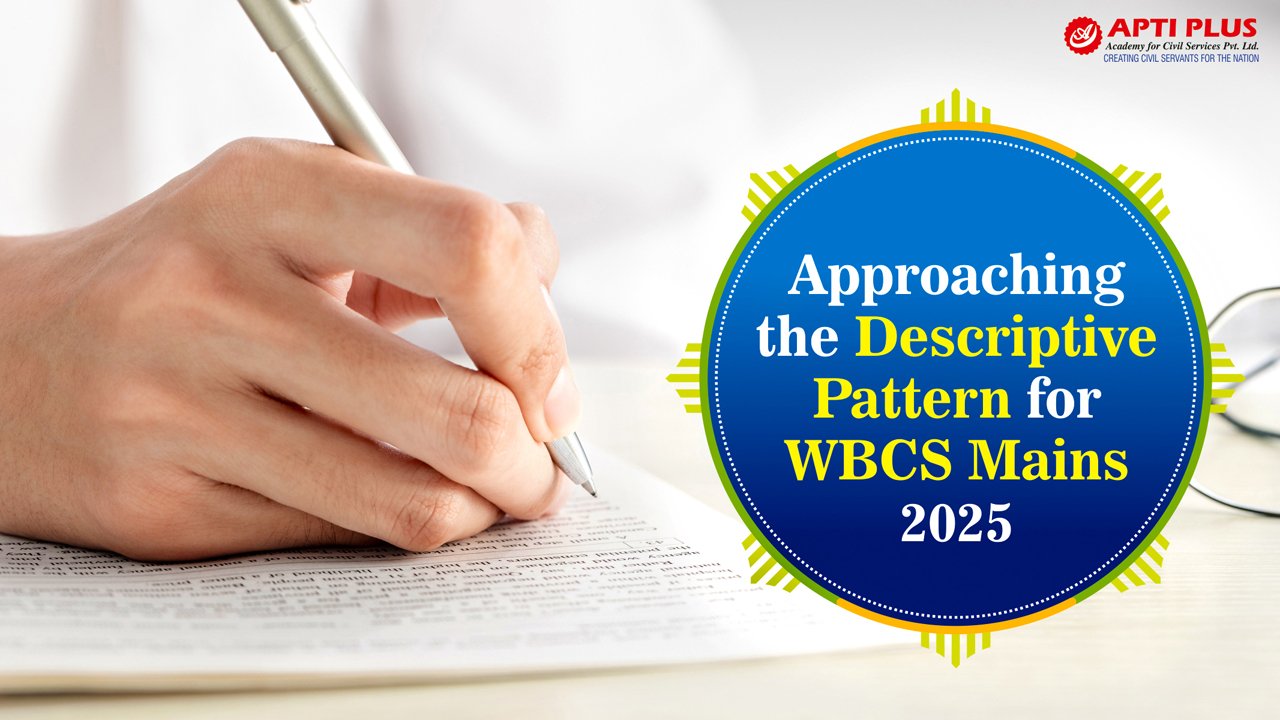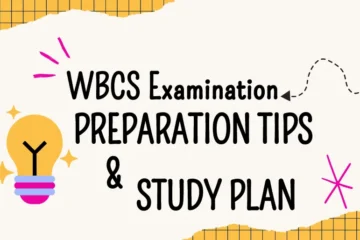Approaching the Descriptive Pattern for WBCS Mains 2025
West Bengal Civil Service (WBCS) Mains 2025 exam is a new challenge for WBCS candidates as not only the syllabus for the exam but also the pattern has changed. These changes require a significant change in the entire test preparation strategy. At APTI PLUS, we offer comprehensive guidance to help candidates adapt to this new format. There is a need to understand this new WBCS mains syllabus and pattern and then practice answer writing to ensure sure shot success in the WBCS mains exam.
Let us first see the changes in the pattern and syllabus.
WBCS Mains Syllabus 2024
- This pattern was more fact-based (objective in nature).
- Here the focus was on the depth of knowledge, rather than analysis.
- The descriptive nature was limited to language-based papers.
| Paper | Subjects | Marks |
| Paper-I | Bengali/Hindi/Urdu/Nepali/Santali | 200 |
| Paper-II | English | 200 |
| Paper-III | General Studies-I: Indian History with emphasis on the National Movement Geography of India with reference to West Bengal | 200 |
| Paper-IV | General Studies-II (Science, Technology, Environment, General Knowledge, Current Affairs) | 200 |
| Paper-V | The Constitution of India, The Indian Economy, Functions of the Reserve Bank of India | 200 |
| Paper-VI | Arithmetic & Test of Reasoning | 200 |
WBCS Mains Syllabus 2025
The focus will be now on how well students can think and explain ideas. Now, the exam is not just about remembering facts. It’s more about understanding concepts deeply, writing clearly, and explaining things in detail. The questions across all papers will test your ability to analyze situations and give thoughtful answers, rather than just recalling information. For those seeking guidance in adapting to this new approach, APTI PLUS, a leading WBCS coaching centre in Kolkata, provides expert mentorship and rigorous training to ensure you excel in the WBCS Mains 2025.
| Paper | Subjects | Marks |
| Paper-I | English Essay & Composition | 250 |
| Paper-II | Tradition & Culture of Bengal | 250 |
| Paper-III to VI | General Studies (I to IV) | 250 each |
| Paper-VII & VIII | Optional Subjects (I & II) | 250 each |
- The Topic ‘Environment’ in Paper General Studies II will include the following: Biodiversity and Coastal Regulation Zone, Global Warming, Industrial and Environmental Pollution, Ozone Layer and related issues.
- The Topic’ Indian Economy including role and functions of the RBI of the compulsory paper -V will consist of the following: Central State Relation and Devolution of Central Funds to State, Planning Process and objective of five years plan. Functions of RBI and Monetary Policy, Central Finance Commission and State Finance Commission and Fiscal Policy of GOI.
Role of Answer Writing in the New Descriptive Pattern
Answer writing will play a crucial role in the new descriptive pattern. Here the WBCS aspirants need to focus on understanding the core demand of the question, structuring and presenting clear and relevant answers (by integrating analytical thinking and effective presentation of arguments).

Important Aspects of Answer Writing
- Clarity and Planning: Before starting writing, spend 1-2 minutes understanding the core demand. Plan the structure (introduction, body, and conclusion).
- Bird’s Eye View: Ensure that the examiner has an idea from the very start, how the answer will flow. For that, continuity and linkage between different parts are important.
- Content Balance: Not much writing about the familiar aspects and too less writing about the important aspects. Maintain a balanced focus on each section of the question.
- Presentation: Handwriting should be clear, subheadings should be well-organized, and key points underlined in order to make a good impression.
- Creative Inputs: Case studies, facts, flowcharts, and inter-topic linkages improve answers. These aspects show the depth of understanding of the aspirant and his/her practical approach.
- Concise and Impactful: Formulate concise, meaningful sentences that carry lots of information without generic filling up the answer.
- Specific Terminology: Focus on the words at the end like discuss, explain, critically examine. Each word comes with its own requirement.
- ELUCIDATE/ EXPLAIN: here the aspirants has to agree with the statement and just explain it through inputs.
- ELABORATE/ SUBSTANTIATE: in this case also the aspirant has to agree with the statement and further support as to how it holds true by giving illustrations, expert views, fact and figures.
- DISCUSS: here the viewpoints of scholars, experts regarding the issue at hand should be mentioned. The viewpoints can be both against and for the motion. It is always better to offer a concluding observation that emerges from the discussion.
- COMMENT/ EXAMINE/ DO YOU AGREE: in this case one has to go one step forward as compared to “discuss” and present their own view/ opinion.
- CRITICALLY EXAMINE/ CRITICALLY EVALUATE: here the anti-viewpoint is to be brought forward. In order to address such a question firstly the opinion/ viewpoint of the critics has to be mentioned and examined and then one’s own concluding remark on the basis of that examination has to be brought out.
How to Understand the Question
Aspirants often misunderstand the specific demand of the question, leading to low marks.
Let’s consider the following question:
Critically examine the impact of climate change on Indian agriculture.
Step 1: Read the Question 2-3 Times
Each reading will help you understand the context of the question better.
Step 2: Break down the Question into Components
- Impact of climate change
- Indian agriculture
- Critical analysis.
Step 3: Identify the Directive
- You need to present both the pros and cons of climate change on Indian agriculture and then provide a balanced assessment.
- Examine the policies and reforms India is using to address these problems.
- Finally you need to give the way forward.
Macro Structure of a Model Answer
Introduction:
- It may contain a definition or a crucial piece of information about the question or the current context of the question.
- Introduction should be crisp, concise and relevant to the question.
Body:
- To make your content easier to read, divide it into subheadings (as per subparts of question).
- Make use of point format and ensure points are crisp and relevant.
- To link different subheadings together, use connecting sentences or connectors.
- Use Examples, data, statistics & Case Studies: to support your claims.
Conclusion:
- Conclude the answer on a positive note.
- If the question demands a specific action, solution, or policy recommendation, conclude with that.
Challenges in Answer Writing
- Time management: Most of the candidates are unable to finish the paper because of poor time management.
- Comprehending the Question: If attention is not paid to reading the question or concentrating on other superficial details may result in fewer marks.
- Inadequate Content: Answers that are too general or superficial are frequently provided.
- Answer Structure: It is difficult to get good marks on an answer if it doesn’t make sense or isn’t organized.
- Visual Appeal: An answer that lacks diagrams, graphs etc, is poorly written, or is not underlined probably will not be attractive.
Techniques to Improve Answer Writing
- Practice Makes Perfect: Consistent writing practice is necessary to enhance content delivery, speed, and structure.
- Peer Review: Ask mentors or peers to evaluate your responses. These comments might be used to pinpoint areas that need work.
- Mock Tests: Write answers in a predetermined amount of time to replicate exam conditions. You’ll gain confidence and time management skills from this.
- Inter-topic Connections: Make an effort to connect related themes. Connect the ideas of geography and economics, for example, or history and culture.
- Utilizing Data and Facts: To give your responses greater credibility, include up-to-date information from papers, case studies, or data.
Model Question and Answer Strategy
Q: Critically examine the impact of fiscal devolution on state-level development in India.
Step-by-Step Approach:
- Introduction: Define fiscal devolution and mention its significance in a federal structure like India.
- Body:
- Positives of Fiscal Devolution: Mention increased financial autonomy for states, better allocation of funds for state-specific needs, and examples of successful projects.
- Challenges: Highlight disparities between states, the over-dependence on central funds, and instances where fiscal devolution hasn’t translated into effective development.
- Case Studies: Mention specific examples like Kerala’s use of devolution for healthcare or Bihar’s challenges in utilizing funds for development.
Conclusion:
Offer a balanced view, suggesting the need for improved governance and capacity-building at the state level to make devolution more impactful.
FAQs
How is APTI PLUS helping students prepare for the new WBCS pattern?
With the shift to the descriptive pattern for WBCS Mains 2025, APTI PLUS provides comprehensive support through its Full Classroom Programme, focused on conceptual clarity, along with a Daily Answer Writing Programme to improve writing skills. Additionally, our Test Series simulates the exam environment, offering detailed feedback to fine-tune strategies.
What are different ways to improve answer writing skills?
The answer is only one! PRACTICE. Writing at least one answer should be a daily habit. However, aspirants should remember that the prerequisite is having solid content preparation. Without it, writing is meaningless.
Can I write the answer in point format or paragraphs?
This would depend on the nature of the question. The introduction should always be in para format. In conclusion, the way forward can be written in point format. The body should contain subheadings with points under them.
How to write in word limit?
There are two things aspirants should do without fail. One is practice and the second is responding to the question- neither more nor less!!
Aspirants must have a well-planned strategy when preparing for WBCS Mains 2025, given the new descriptive format. Understanding the changes, addressing the challenges, and practicing regularly will be key to success. Finally, nothing substitutes good content, and this comes with good preparation, hard work, and commitment!





